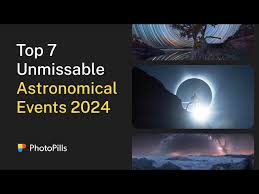Astronomy Events: Exploring the Wonders of the Universe
From meteor showers to planetary alignments, astronomy events offer a fascinating glimpse into the vast expanse of our universe. These celestial occurrences provide opportunities for stargazers and astronomers alike to witness the beauty and mysteries of space. Let’s delve into some of the most captivating astronomy events that occur throughout the year:
Meteor Showers
Meteor showers occur when Earth passes through debris left behind by comets or asteroids. These cosmic spectacles light up the night sky with shooting stars, creating a mesmerizing display for observers. Popular meteor showers include the Perseids in August and the Geminids in December.
Lunar Eclipses
During a lunar eclipse, Earth’s shadow partially or completely covers the Moon, giving it a reddish hue known as a “blood moon.” Lunar eclipses are awe-inspiring events that remind us of the intricate dance between Earth, the Moon, and the Sun.
Planetary Alignments
Planetary alignments occur when multiple planets appear close together in the night sky from our vantage point on Earth. These rare alignments offer a striking visual spectacle and provide insights into the movements of celestial bodies in our solar system.
Solar Eclipses
Solar eclipses occur when the Moon passes between Earth and the Sun, casting a shadow on our planet. Total solar eclipses are particularly captivating as they darken the sky during daytime, revealing the Sun’s outer atmosphere known as the corona.
Comet Sightings
Comets are icy bodies that journey through our solar system, leaving behind glowing tails as they approach the Sun. Witnessing a comet streak across the sky is a rare and magical experience that evokes wonder and curiosity about these celestial travelers.
Whether you’re an amateur stargazer or an experienced astronomer, astronomy events offer opportunities to marvel at the wonders of our universe and deepen our understanding of space beyond Earth’s boundaries.
Top 5 Frequently Asked Questions About Upcoming Astronomy Events
- When is the next meteor shower and how can I best observe it?
- What causes a lunar eclipse and when is the next one expected?
- How often do planetary alignments occur, and which planets are involved in the next alignment?
- What safety precautions should I take when viewing a solar eclipse?
- How can I track upcoming comet sightings and where is the best place to view them?
When is the next meteor shower and how can I best observe it?
The next meteor shower to look forward to is the Perseids, which typically occurs in August each year. To best observe this celestial event, find a location away from city lights with a clear view of the night sky. Plan your observation during the peak hours when meteor activity is expected to be highest, usually after midnight. Bring a comfortable chair or blanket, dress warmly, and give your eyes time to adjust to the darkness. Patience is key when watching meteor showers, so relax and enjoy the natural spectacle as shooting stars streak across the heavens above.
What causes a lunar eclipse and when is the next one expected?
A lunar eclipse occurs when Earth comes between the Sun and the Moon, causing Earth’s shadow to fall on the Moon. This alignment creates a captivating celestial event where the Moon may appear to turn a reddish hue, known as a “blood moon.” The next lunar eclipse is expected to occur on [insert date], offering stargazers and astronomy enthusiasts a chance to witness this natural phenomenon firsthand. Lunar eclipses serve as a reminder of the intricate celestial dance between Earth, the Moon, and the Sun, showcasing the beauty and wonder of our cosmic neighborhood.
How often do planetary alignments occur, and which planets are involved in the next alignment?
Planetary alignments occur relatively infrequently due to the complex orbits of the planets in our solar system. The frequency of planetary alignments varies depending on the specific alignment being observed. In general, alignments involving multiple planets are rarer than those involving only two planets. The next notable planetary alignment set to occur is the conjunction of Jupiter and Saturn, also known as the “Great Conjunction.” This event happens roughly every 20 years, with the most recent one taking place in December 2020. During a Great Conjunction, Jupiter and Saturn appear close together in the night sky, creating a stunning celestial sight for observers on Earth.
What safety precautions should I take when viewing a solar eclipse?
When viewing a solar eclipse, it is crucial to take proper safety precautions to protect your eyes from the harmful effects of direct sunlight. Looking directly at the sun, even during an eclipse, can cause permanent damage to your eyesight. To safely observe a solar eclipse, use certified solar viewing glasses that meet the ISO 12312-2 international safety standard. These glasses block out the majority of harmful ultraviolet and infrared radiation while allowing you to see the eclipse clearly. Additionally, you can use solar filters on telescopes or binoculars to safely view the eclipse. Remember never to look at the sun through unfiltered cameras, telescopes, or other optical devices without appropriate solar filters. By following these safety guidelines, you can enjoy the awe-inspiring sight of a solar eclipse without risking your vision.
How can I track upcoming comet sightings and where is the best place to view them?
Tracking upcoming comet sightings involves staying informed about astronomical events and utilizing resources such as astronomy websites, apps, and observatories that provide updates on celestial phenomena. To locate the best place to view comets, consider factors like light pollution levels, weather conditions, and the comet’s position in the night sky. Optimal viewing locations are often areas with minimal light pollution, clear skies, and unobstructed views of the horizon. Amateur astronomers can enhance their comet-watching experience by using telescopes or binoculars to observe these cosmic visitors up close and appreciate their beauty in the vast expanse of the night sky.

